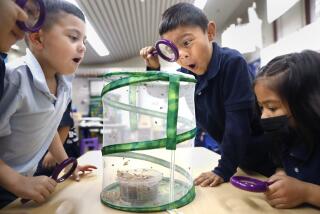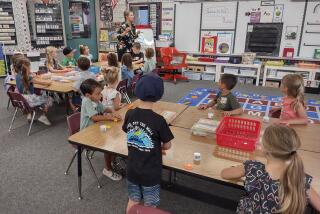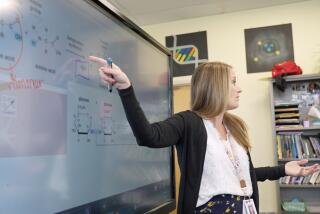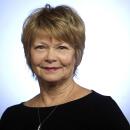Ready or Not?
- Share via
BERKELEY — “School readiness” is on the minds of more and more educators and parents these days. But the debate rages over how best to get preschoolers primed for the increasingly rigorous demands of kindergarten.
Should they learn the old-fashioned way--by playing with peers under the watchful eyes of caring “baby-sitters” who keep them from harm and encourage their social and emotional development? Or are their 3- and 4-year-old minds ready to tackle phonics and tetrahedrons?
There are signs in some pockets that the learn-by-playing advocates and the learn-by-instruction proponents are finally seeking some common ground, in recognition that both aspects are necessary for a child’s success in school and life.
Consider:
* California in May will unveil its first guidelines for preschools for children aged 3 through 5. They will emphasize the influence of family and culture on academic success and reiterate the need for parents to read regularly to and interact with their youngsters.
* At a Berkeley preschool where playtime and early literacy are well established, 4-year-olds now spend 40 minutes a week getting exposure to the rudiments of arithmetic and geometry. Meanwhile, this year for the first time, the National Council of Teachers of Mathematics’ standards will cover pre-kindergarten.
* Vice president and presidential candidate Al Gore and Delaine Eastin, California’s superintendent of public instruction, are among a growing cadre of politicians and educators clamoring for universal preschool.
Over the last three decades, research has revolutionized educators’ thinking about how babies and children learn. Among the chief findings have been that even very young children can grasp complex concepts and that stable, nurturing care enhances learning.
Quality of Child Care
The research is verifying what mothers have long known: that children learn more exuberantly when their relationships with caregivers and family members are steady and warm.
Studies also indicate that 3- and 4-year-olds who attend high-quality preschools are more likely to do well academically and socially. They are less likely to drop out of school, commit crimes or be placed in special education classes. They generally have more successful professional lives.
Low-income children, in particular, benefit from preschool experiences, researchers say, because they typically come from homes where exposure to reading and math is limited.
“[Such] children are already behind when they reach the classroom door,” said Nicholas Zill, vice president and director of Westat, a Washington research organization. It is becoming clear, Zill added, that achievement difficulties among disadvantaged children cannot be blamed solely on bad schools.
Quality child care would be a balm for this social ill. Unfortunately, experts note, the supply of reliable, affordable child care and preschool has not kept up with rising demand as more women, including those on welfare, enter the work force.
Aside from New York and Georgia, which have broadly based preschool programs, most states have steered clear of embracing universal preschool and from adopting standards for early childhood education. California, for one, is hampered by the high cost that universal preschool would entail and a drastic shortage of qualified teachers and space.
Still, if the choice is between class-size reduction and preschool, the evidence indicates that preschool is more effective, noted Edward F. Zigler, a professor at Yale who was the father of the nation’s Head Start program for low-income children.
One noted child care expert calls the failure to promote preschool “definitely misguided.”
If care providers are “only protecting health and safety, that is a lost opportunity” for learning, said Joan Lombardi, a former director of the child care bureau of the U.S. Department of Health and Human Services.
Many early childhood authorities say states have focused instead on content standards, testing and accountability measures for kindergarten through 12th grade.
Under such high-stakes systems, teachers, starting in kindergarten, are feeling pressured to show that their students are achieving.
Kindergarten teachers are thus pleading for better prepared pupils. To some teachers, readiness means that children can recite the alphabet, count to 10 and print legibly. More essential for others is that children know how to sit still, understand and follow directions and cooperate with classmates. All agree that eagerness to learn is a key element.
California’s new preschool guidelines will attempt to address those concerns. The state Department of Education consulted with scores of early childhood authorities and aligned the guidelines with state content standards. State officials will use training videos to get the word out to preschool teachers statewide.
“Children come . . . ready to learn,” said Sharon Hawley, a department consultant who worked on the project. “It’s the adults who need to be attuned with what’s going on with the child.”
National Goals Set a Decade Ago
School readiness has been on the U.S. education agenda since 1989, when President George Bush and the nation’s governors agreed on half a dozen goals that states should meet by 2000. The first was that all children would start school ready to learn.
The readiness goal had three objectives: to ensure that all children would have access to high-quality and developmentally appropriate preschool programs; to promote parents as children’s first teachers; and to ensure that all children start school with healthy minds and bodies.
The results are mostly good. In its first report on the nation’s youngest students, the U.S. Department of Education revealed last month that the vast majority of children enter kindergarten well behaved and in good health and knowing the alphabet and numbers. Poorer classmates, however, tend to start from behind.
“Whether or not children succeed in school is in part related to events and experiences that occur prior to their entering kindergarten,” the report said. “Children’s preparedness for school involves a complex and continuous collaboration between the child and the family.”
The study looked at a national sample of 22,000 youngsters who entered private and public kindergartens in the fall of 1998.
Until the pupils are in fifth grade, the agency plans to test them regularly in math and reading and observe them for physical well-being and social development. The goal, researchers say, is to see how early childhood nutrition, education and other nurturing contribute to a child’s long-term school performance.
At the Harold E. Jones Child Study Center in Berkeley, researchers are seeing big gains in knowledge when 3- and 4-year-olds are exposed to math through game-like activities using goldfish crackers, puppets and craft supplies. The curriculum is being tested at the center and in nine other East Bay preschools.
For decades, the center has been a focus of UC Berkeley’s Institute of Human Development, where experts have been studying how children learn such subjects as math and reading and how playtime and family life affect school performance.
The center is an example of “intentional” education for 3- to 5-year-old children.
Developed by two UC Berkeley researchers, the math curriculum is designed to bridge the gap in math knowledge that research shows exists between low- and middle-income children in the nation before they enter kindergarten. The chasm is particularly pronounced when U.S. children are compared with their preschool counterparts in China and Japan.
One recent day, four 4-year-olds sat at a peewee-size table at the center, the daytime home for four dozen youngsters of UC Berkeley faculty and staff. Using toothpicks and balls of clay, they formed triangles. Their teacher showed them how to turn those figures into pyramids, or tetrahedrons.
Throughout the lesson, the teacher, Berta Ortega-Plate, demonstrated how children could use the figures playfully--as cameras or as tents or just to peer through. Although all four youngsters appeared to be intrigued by the activity, they progressed at wildly different rates. One girl finished quickly each time, holding up her work with a proud smile. Another, frustrated, put her head on the desk.
The disparity demonstrated the range that exists among all children and the importance of having a well trained teacher who can tailor lessons to suit each child.
Preschool teachers have not generally been trained to support math, and parents put a higher priority on reading, researchers Prentice Starkey and Alice Klein found.
“Parents are thinking about literacy, but math is lagging behind,” Starkey said.
In field testing, the researchers found that the curriculum raised awareness of math on the part of teachers and parents. Teachers began singing songs about numbers. Some parents made up number games at home. Children’s scores on math assessments have improved markedly, the researchers said.
First Five Years Seen as Crucial
Even among the institute’s experts, however, the debate rages on as to how much “intentional” education--versus self-motivated and self-guided play--should be directed at children.
Favoring the self-guided side is Alison Gopnik, a psychology professor at UC Berkeley and co-author of “The Scientist in the Crib” (William Morrow & Co., 1999).
“Arguably, children are learning more in their first five years than in the rest of their lives,” Gopnik said.
From birth, she said, babies are testing hypotheses, drawing conclusions and doing experiments. They are figuring out how the physical world works--that things fall down, not up, for example. Most striking, they’re learning about other people.
Still, she acknowledges that “pre-reading and pre-math” activities help very young children accomplish the learning they are doing naturally.
Lombardi, the former child care bureau chief, favors the hunt for the middle ground.
“The push for readiness shouldn’t be about the push for regimentation,” Lombardi said. “Encouraging curiosity, motivation and a love of learning. That’s what school readiness should be about.”
More to Read
Sign up for Essential California
The most important California stories and recommendations in your inbox every morning.
You may occasionally receive promotional content from the Los Angeles Times.











